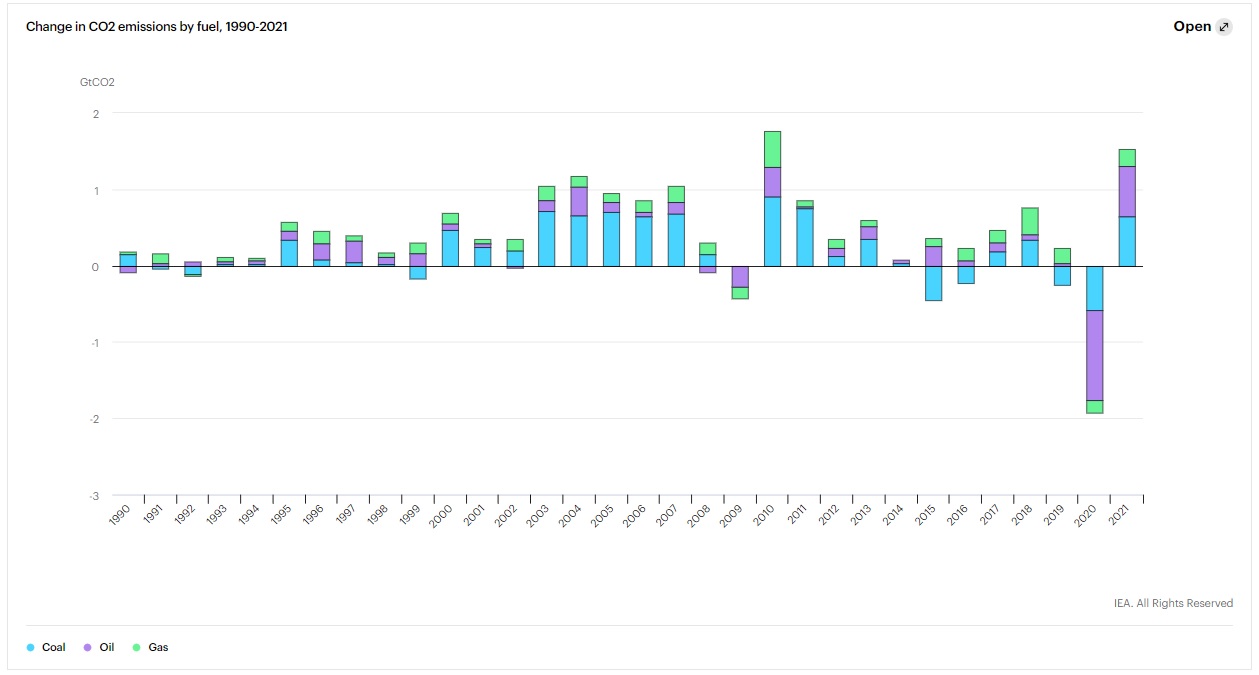Global Energy Review 2021 – Analysis - IEA
Global CO2 emissions declined by 5.8% in 2020, or almost 2 Gt CO2 – the largest ever decline and almost five times greater than the 2009 decline that followed the global financial crisis. CO2 emissions fell further than energy demand in 2020 owing to the pandemic hitting demand for oil and coal harder than other energy sources while renewables increased. Despite the decline in 2020, global energy-related CO2 emissions remained at 31.5 Gt, which contributed to CO2 reaching its highest ever average annual concentration in the atmosphere of 412.5 parts per million in 2020 – around 50% higher than when the industrial revolution began.
In 2021 global energy-related CO2 emissions are projected to rebound and grow by 4.8% as demand for coal, oil and gas rebounds with the economy. The increase of over 1 500 Mt CO2 would be the largest single increase since the carbon-intensive economic recovery from the global financial crisis more than a decade ago, it leaves global emissions in 2021 around 400 Mt CO2, or 1.2%, below the 2019 peak.
Despite global economic activity rising above 2019 levels in 2021 and global energy demand rebounding above 2019 levels, we do not anticipate a full return of CO2 emissions to pre-crisis levels. Even with an increase in CO2 emissions from oil of over650 Mt CO2 in 2021, oil-related emissions are expected to recover only around half of the 2020 drop and thus should remain 500 Mt CO2 below 2019 levels. The likely partial recovery is entirely due to the continued impacts of the Covid‑19 pandemic and related restrictions on transport activity in 2021. CO2 emissions from international aviation are set to remain 200 Mt CO2 (or one-third) below pre-pandemic levels in 2021, while emissions from road transport and domestic aviation are on track to be close to 350 Mt CO2 (or 5%) below 2019 levels in 2021. A full recovery of global transport activity would push oil-related emissions above 2019 levels and increase global CO2 emissions by over 1.5%, well above 2019 levels.
Biden climate summit: White House unveils high-profile lineup
White House unveils plans for high-profile climate summit
The Biden administration offered new details this morning about the big, virtual climate summit Thursday and Friday and signaled they expect new emissions reduction and climate finance commitments from multiple countries.
Driving the news: The administration said 40 heads of state would attend, including Russian President Vladimir Putin and President Jair Bolsonaro of Brazil.
- They unveiled a lineup that also includes high-profile names, such as Pope Francis, Bill Gates, the heads of NATO and the World Bank, corporate executives and more.
Why it matters: The White House is trying to reassert U.S. leadership on the climate issue and encourage other countries to make commitments to slash emissions before 2030.
The intrigue: On a call with reporters this morning, officials laid out the summit agenda, but did not say what additional commitments the U.S. will be making on the emissions or climate finance front.
- However, it is widely expected the U.S. will commit to reducing emissions by at least 50% below 2005 levels by 2030, which would put the country near the top of the pack when it comes to emissions targets.
What they're saying: "We expect action at this meeting. We're looking for people to make announcements to raise their ambition to indicate next steps that they intend to be taking to help solve the climate problem and to work collectively to do so," a senior administration official told reporters.
- The administration is also looking to use the summit to showcase its all of government approach to climate — the event will include not only the heads of environmental agencies but also officials like the secretary of defense and the director of national intelligence.
The big picture: The summit comes just after the European Union agreed to a provisional deal overnight on sweeping climate legislation that aims to slash the bloc's net greenhouse gas emissions by 55% compared to 1990 levels by 2030.
Quick take: Biden administration officials can use the deal to show that other countries are acting as President Biden presses Congress for huge new investments and unveils a non-binding target to steeply cut U.S. emissions this decade.
- "Our political commitment to becoming the first climate neutral continent by 2050 is now also a legal commitment," European Commission President Ursula von der Leyen said in a statement.
- In addition, China, the world's largest emitter, announced that President Xi Jinping would attend the virtual summit despite deep tensions with the U.S.
- Separately, the U.K. also announced tougher emissions goals this week, targeting a 78% cut by 2035 compared to 1990 levels.
What we're watching: All eyes are on other countries — notably Japan and Canada — to see if they unveil new targets, and other nations' moves made to date are not necessarily because of the U.S. return to the world stage.
- The U.S. goes into the summit with a credibility gap after former President Donald Trump withdrew from the Paris Agreement. Biden moved to rejoin on his first day in office.
Good BBC interview with Michael Mann.
https://www.bbc.co.uk/sounds/play/w3ct1nb2
HARDtalk - Michael Mann: The new climate war?
Results 1 to 25 of 6901
Thread: Any doubts about Climate Change?
Threaded View
-
22-04-2021, 03:37 AM #11
Thread Information
Users Browsing this Thread
There are currently 28 users browsing this thread. (0 members and 28 guests)








 Reply With Quote
Reply With Quote